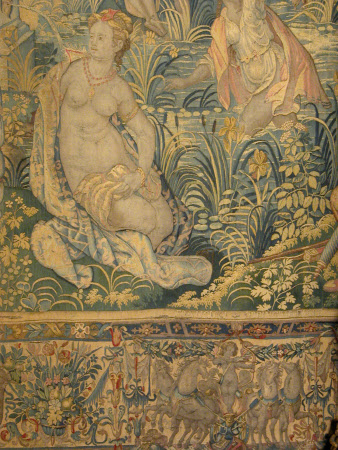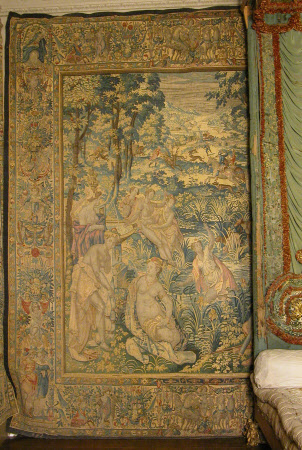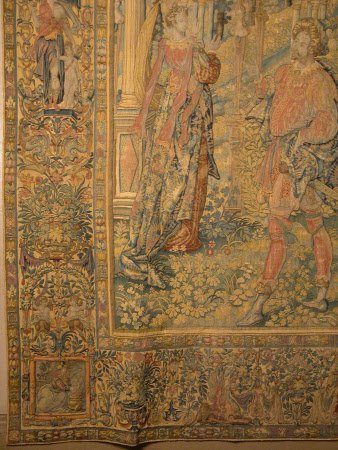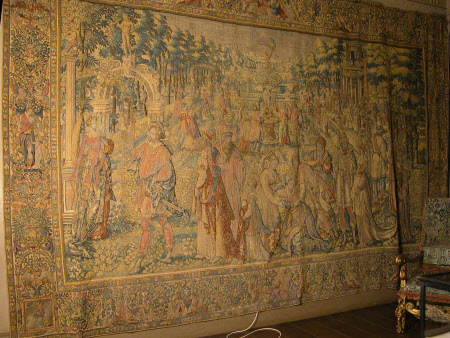Tapestry depicting Diana and Actaeon
François Spiering (c. 1551-1631)
Category
Tapestries
Date
circa 1590 - circa 1610
Materials
Tapestry, wool and silk, 8 warps per cm
Measurements
358 x 334 cm
Place of origin
Delft
Order this imageCollection
Knole, Kent
NT 130081.2
Summary
Tapestry, Diana and Actaeon from a set of two of the Story of Diana, from the workshop of François Spiering, Delft, c. 1590-1610. The scene is a woodland setting where Diana and her nymphs are bathing in a fountain. In the left foreground two semi-naked nymphs dry themselves by the water’s edge. In the right foreground are two more nymphs, one sitting and one standing, looking after Diana’s bow and arrows, her clothes and her two hunting dogs. Diana herself, identifiable by the crescent moon on her brow, appears further back on the left, sitting by the stone bowl of a fountain and bathing with two more nymphs. As Actaeon appears on the opposite side of the water with his dogs, one of her nymphs hurries to cover her body. Diana raises her left arm in alarm and splashes Acteon with water, turning him into a stag – horns can be seen sprouting from his head. In the background huntsmen and dogs hunt and kill a stag (Actaeon), and there is a distant view to hills on the horizon. The tapestry has deep ornamental borders decorated with foliage, scrollwork and small figures. In the centre of the upper and lower border is a figure of Cupid driving a chariot drawn by four horses. Victory and Fame appear in the upper corners, and in the lower corners there are pairs of figures labelled ‘VLYSSES ET CIRCE’ and ‘IVPITER ET CALISTO’. At the upper edge of the lower border the tapestry is signed ‘FRANCISCVS SPIRINGIVS FECIT’.
Full description
The story of Diana and Actaeon is told in Ovid’s ‘Metamorphoses’ (Book 3). The huntsman Actaeon accidentally stumbled upon Diana and her nymphs bathing while he was out hunting in the forest with his friends. Actaeon, standing near the centre of the tapestry, has just seen Diana and raises his hand in surprise as her nymphs hurry to hide her naked body. The goddess is furious to have been seen bathing and she splashes water in the young man’s face, and turns him into a stag. The water is seen in the tapestry shooting towards him, and antlers are already sprouting from his head. Actaeon’s swift demise is enacted by the tiny figures in the background of the tapestry. He fled the scene but his hounds saw him and gave chase; he tried to tell them he was their master but could not speak, and the hounds devoured him, cheered on by Actaeon’s friends who called his name, unaware of his transformation and wondering why he was not there to witness the kill. ‘Niobe’s Pride’ and ‘Diana and Actaeon’, come from a series of the ‘Story of Diana’ made at the workshop of François Spiering in Delft, after designs by Karel van Mander. A third tapestry in the Venetian Ambassador’s Room at Knole, ‘Oriane Passing the Magical Love Test’ (no. 128792), was also woven by Spiering and designed by Van Mander, but comes from a different series, the ‘Story of Amadis de Gaule’. As many as ten scenes are known from the ‘Diana’ series: ‘Jupiter and Callisto’, ‘Diana and Actaeon’, ‘Actaeon Torn to Pieces by his Hounds’, ‘Niobe’s Pride’, ‘Latona Fleeing from Juno and the Serpent Python’, ‘Latona and the Lycian Peasants’, ‘Cephalus and Procris’, ‘The Death of Procris’, ‘The Story of Lelaps and the Giant Vixen’, and ‘Mealeager and Atalanta’. The largest surviving group is a set of six in the Rijksmuseum, Amsterdam (Hartkamp-Jonxis and Smit 2005, pp. 203-14; Hartkamp-Jonxis 2009). Francis Spiering, who produced the ‘Diana’ tapestries at Knole, also produced another ‘Diana’ series with smaller figures and smaller overall dimensions. The designer of the ‘Diana’ series is not recorded, however the tapestries are stylistically very similar to another series woven by Spiering, the ‘Story of Amadis de Gaule’, of which one tapestry is also at Knole. One surviving tapestry from the ‘Amadis’ series bears the initials of the Karel van Mander I (1548-1606), who designed the set. The ‘Diana’ series is thus attributed to van Mander on stylistic grounds. The tapestries were made by François Spiering, whose signature appears at the upper edge of the lower border, and whose monogram is woven into the right hand galloon of ‘Diana and Actaeon’. Spiering is first recorded as a tapestry entrepreneur in Antwerp in the 1570s. In 1576, when the town was sacked by Spanish troops who stole many tapestries from the vast ‘Pand’ or dealer’s warehouse in the town, he lost a large amount of stock. As a Mennonite protestant he then fled the Southern Netherlands, which were controlled by the Catholic Habsburgs, and settled in Delft in the newly independent United Provinces of the Northern Netherlands. He set up a tapestry workshop in an abandoned convent given to him by the Delft city authorities in 1592, but may have been working in the town during the 1580s. Spiering produced tapestries that were quite distinct from anything being made in the Southern Netherlands. His tapestries were characterised by the elegant, elongated figures and complex narratives provided by Karel van Mander, an exquisite attention to pattern and surface detail, a fine weave with a high silk content and a subtle colour palette. Spiering’s tapestries soon gained popularity among the Protestant courts of Northern Europe and he worked for the King of Sweden and the authorities of many Northern Netherlandish provinces, but perhaps his greatest success was with the English court. In 1592 he received a commission for a set of tapestries of the ‘Spanish Armada’ from Charles Howard of Effingham, which would be one of the most iconic tapestry sets in England for the next 200 years (See Farrell 2010). The Diana series was Spiering’s most successful tapestry series and appears to have been particularly popular with English clients. This may have been due the association of Elizabeth I, the ‘Virgin Queen’, with the goddess Diana; certainly the first appearance of the Diana tapestries was in 1593, when a set of twelve was commissioned by the Royal favourite Sir Walter Raleigh (van Ysselsteyn 1936, vol. I, pp. 70, 75 and nos. 104, 165). A decade later another set was commissioned by Thomas Howard, first Earl of Suffolk. A number of other English commissions and gifts are recorded, including a purchase of ‘three pieces of fine tapestry hangings’ from ‘Francois Spierincx, Merchant Stranger’ for King James I in 1607 (CSP Dom 1603-10, p. 371; for details on Spiering’s career see Donnet 1894; Van Ysselsteyn 1936, passim; Campbell 2007, pp. 22-27; Hartkamp-Jonxis 2009, pp. 20-28). ‘Diana and Actaeon’ bears the mark of the city of Brussels (two Bs either side of a red shield) on its lower galloon, along with Spiering’s signature. Spiering used the same mark on other tapestries, although he probably never worked in Brussels. It has been suggested that he used the mark as a sign of quality, since Brussels tapestries were general regarded as the finest during the sixteenth century. It is also possible that he used the mark as a gesture of defiance against the authorities of the Southern Netherlands. Spiering was probably still using the Brussels mark after his establishment in Delft, but later he began using the mark of that city, ‘H – D’ for ‘Holland – Delft’. Along with ‘Diana and Actaeon’ and ‘Niobe’s Pride’ a third tapestry by Spiering, ‘Oriane Passing the Magical Love Tests’ from the ‘Story of Amadis de Gaule’ also hangs in the Venetian Ambassador’s Room at Knole. Their earlier provenance is unknown, but it is possible that they originate in the English Royal Collection, and there are two potential routes for their arrival at Knole. Lionel Cranfield, 1st Earl of Middlesex (1575-1645), a prominent politician under James I, received perquisites from the Royal Collection in his role as Master of the Wardrobe; his daughter Frances Cranfield married Richard, 5th Earl of Dorset (1622-77) and his collection, much of it kept at Copt Hall in Essex, eventually came to Knole. Charles, 6th Earl of Dorset (1638-1706) also received royal perquisites as Lord Chamberlain in the 1690s, and many of these goods first went to Copt Hall before being brought to Knole, along with the Cranfield chattels, when Copt Hall was sold in 1701. The lists of goods brought from Copt Hall to Knole in 1700-01 include a number of tapestries, but none can definitely be identified as the three Spiering pieces. They may be the ‘Three peices of very fine Tapistry Storys out of Ovid 10. Foot Deep’ in the Wardrobe at Knole in the 1706 inventory (MS kept at Knole). References to the description of ‘Oriane Passing the magical Love Tests’ as a ‘Garden Scene’ in 1705 are incorrect, and based on a misreading of Phillips 1930 (p. 449). The tapestries may have been installed in the Venetian Ambassador’s Room when it was remodelled by William Kent in c. 1730. (Helen Wyld, 2012)
Provenance
Given to the National Trust with the house and part of the contents by Major-General Sir Charles Sackville-West, 4th Lord Sackville (1870 – 1962) in 1946
Credit line
Knole, The Sackville Collection (The National Trust)
Marks and inscriptions
Below figures in lower left corner: VLYSSES ET CIRCE Below figures in lower right corner: IVPITER ET CALISTO At upper edge of lower border: FRANCISCVS SPIRINGIVS FECIT On lower galloon: the letters ‘BB’ either side of a red shield (mark of the city of Brussels) On right hand galloon: mark of François Spiering
Makers and roles
François Spiering (c. 1551-1631), workshop Karel van Mander (Meulebeke 1548 - Amsterdam 1606), designer
References
Donnet, 1894: Fernand Donnet, ‘Les tapisseries de Bruxelles, Enghien et Audenarde pendant la furie Espagnole (1576)’, Annales de la société d’Archéologie de Bruxelles, vol. 8 (1894), pp. 442-476 CSP Dom 1603-1610: Calendar of State Papers, Domestic: James I, 1603-1610, London 1857 van Ysselsteyn, 1936: G T van Ysselsteyn, Geschiedenis der tapijtweverijen in de noordelijke Nederlanden. Bijdrage tot de geschiedens der kunstnijverheid, 2 vols., Leiden 1936 Erkelens 1962: A M Erkelens, ‘De Wandtapijtkunst te Delft,’ Oud Delft, Vol 1 (1962) Standen 1988: Edith Standen, ‘Some Tapestries at Princeton’, Record of the Art Museum at Princeton University, vol. 47, no. 2 (1988), pp. 8-11 Luijten 1993: Ger Luijten (ed.), The Dawn of the Golden Age: Northern Netherlandish Art 1580-1620, exh. cat. Rijksmuseum, Amsterdam 1993 Desprechins de Gaesebeke 1996a: Anne Desprechins de Gaesebeke, ‘Une Tenture d’Amadis de Gaule tissée à Delft d’après les cartons de Karel van Mander’, Gentse bijdragen tot de kunstgescheidenis en oudheidkunde, 31 (1996), pp. 81-96 Desprechins De Gaesebeke, 1996: Anne Desprechins De Gaesebeke. “A la gloire d’Amadis: tapisseries de Delft d’apres Karel van Mander.” Gazette des Beaux-Arts 128.1535 (1996): pp.253-62. Liedtke 2001: Walter A Liedtke (ed.), Vermeer and the Delft School, exh. cat. Metropolitan Museum of Art, New York 2001 Hartkamp-Jonxis and Smit, 2004: Ebeltje Hartkamp-Jonxis and Hille Smit, European Tapestries in the Rijksmuseum, Amsterdam 2004 Zanni 2005: Annalisa Zanni (ed.), Le imprese tessute di Amadigi di Gaula. Due arazzi del Museo Poldi Pezzoli, Milan 2005 Campbell, 2007a: Thomas Campbell et al., Tapestry in the Baroque: Threads of Splendor, exh. cat. Metropolitan Museum of Art, New York 2007 Campbell, 2007a: Thomas Campbell et al., Tapestry in the Baroque: Threads of Splendor, exh. cat. Metropolitan Museum of Art, New York 2007 Franses 2007: Dutch Tapestry in the Golden Age: 1590-1650, exh. cat. Franses, New York 2007 Hartkamp-Jonxis 2009: Ebeltje Hartkamp-Jonxis, Weaving Myths: Ovid’s Metamorphoses and the Diana Tapestries in the Rijksmuseum, Amsterdam 2009 Farrell 2010: Stephen Farrell, ‘The Armada Tapestries in the Old Palace of Westminster’, Parliamentary History, vol. 29, part 3 (2010), pp. 416-440 Fryman and Town 2011: Olivia Fryman and Edward Town, ‘Lionel Cranfield and the Furnishing of Chelsea House 1620-25’, Furniture History Society Newsletter, pp. 1-5




